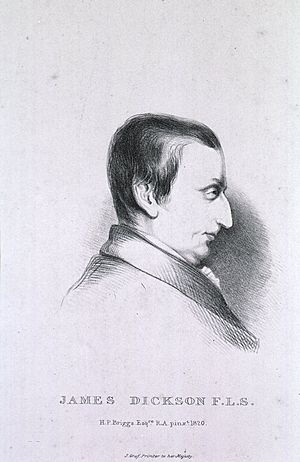James Dickson (botanist) facts for kids
Quick facts for kids
James Dickson
|
|
|---|---|

James Dickson, 1820 engraving
|
|
| Born | 1738 Kirke House, Traquair, Peeblesshire
|
| Died | 1822 |
| Nationality | Scottish |
| Occupation | Nurseryman, plant collector, botanist and mycologist |
James Dickson (1738–1822) was a Scottish expert who studied and collected plants. He was a nurseryman (someone who grows and sells plants), a plant collector, a botanist (a plant scientist), and a mycologist (someone who studies fungi). He wrote important books about plants and fungi found in the British Isles. One of his famous works, published between 1785 and 1801, described over 400 types of algae and fungi. A group of plants called Dicksonia (which are a type of tree-fern) was named in his honor.
Life of James Dickson
James Dickson was born in 1738 at Kirke House, Traquair, in Peeblesshire, Scotland. His family was not wealthy. He started his career working in the gardens of the Earl of Traquair.
When he was still young, he moved to Brompton to work at Jeffery's nursery-garden. In 1772, he decided to start his own business in Covent Garden, London.
Between 1785 and 1791, Dickson traveled several times through the Scottish Highlands. He went there to find and collect different kinds of plants. In 1789, he went on one of these trips with Mungo Park, a famous explorer. Mungo Park's sister later became James Dickson's second wife.
In 1788, James Dickson became one of the first members of the Linnean Society. This is a famous group for people who study natural history. Later, in 1804, he was also one of the first eight members and a vice-president of the Horticultural Society. This society focuses on growing plants.
James Dickson passed away on August 14, 1822, in Broad Green, Croydon, Surrey. His wife, a son, and two daughters survived him.
James Dickson's Works
Sir Joseph Banks, a well-known botanist, allowed James Dickson to use his large library. This helped Dickson learn a lot about botany, especially about cryptogamic plants. These are plants that do not produce flowers or seeds, like fungi, algae, and mosses.
Dickson published several important books:
- Between 1785 and 1801, he published four books called Fasciculi Plantarum Cryptogamicarum Britanniæ. These books contained descriptions of 400 different species.
- From 1789 to 1799, he created A Collection of Dried Plants, named on the authority of the Linnæan Herbarium. This was a collection of dried plant samples, with 25 species in each of its 17 parts.
- In 1795, he published a Catalogus Plantarum Cryptogamicarum Britanniæ. This was a list of cryptogamic plants found in Britain.
- Between 1793 and 1802, he worked on his Hortus Siccus Britannicus. This was another collection of dried plants, published in 19 parts.
He also wrote articles for the 'Transactions of the Linnean Society'. James Edward Smith, another botanist, wrote a special message in his memory. A French botanist, Charles Louis L'Héritier de Brutelle, named the plant group Dicksonia after him. These plants are a type of tree-fern.
See also
 In Spanish: James Dickson para niños
In Spanish: James Dickson para niños
- Category:Taxa named by James Dickson (botanist)

